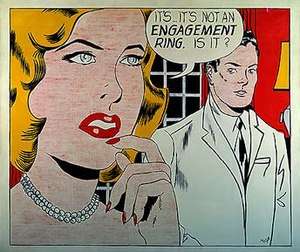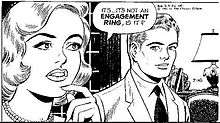Engagement Ring (Lichtenstein)
Engagement Ring is a 1961 pop art painting by Roy Lichtenstein. The work is based on the Winnie Winkle series, but Lichtenstein changed both the graphical description and the narrative accompaniment that he presents in a speech balloon.[1] As with most of his early romance comics works, this consisted of "a boy and a girl connected by romantic dialogue and action".[2]
| Engagement Ring | |
|---|---|
 | |
| Artist | Roy Lichtenstein |
| Year | 1961 |
| Movement | Pop art |
| Dimensions | 172.1 cm × 201.9 cm (67 3⁄4 in × 79 1⁄2 in) |
Details

The original source was a Martin Branner panel from the July 16, 1961 Winnie Winkle published in the Chicago Tribune.[3] Measuring 172.1 cm × 201.9 cm (67 3/4 in × 79 1/2 in), Engagement Ring's "patchy" screen of small flesh coloring Ben-Day dots and "staccato" drawing are considered tentative.[4] The general "rawness" of the work links it to Lichtenstein's work from the 1950s, while its "integrated formality" links it to his subsequent works.[4] Lichtenstein used only a few basic colors, with the same red being used for the fingernails, lips, drapes, and wall, while the same yellow provided the color for the hair and the lampshade.[4] Although the painting is considered "a fully characteristic painting, conceptually and manually", it is not as poised a composition as his subsequent works.[4] The style of the painting is described as "dry" and with "the color compression and linear simplification of the comics are dilated to the scale of easel painting".[5] Using a single frame of a comic book source draws the reader in without providing closure with a clear expected outcome and without explaining the circumstances.[6]
When Lichtenstein had his first solo show at The Leo Castelli Gallery in February 1962, it sold out before opening. Engagement Ring was one of the works in the show (along with works such as Look Mickey,[7] Blam and The Refrigerator) and it sold for $1200 ($10,143 in 2019 dollars[8]).[9] The show ran from February 10 through March 3.[10] In 1962, Lichtenstein produced several paintings about engagement rings and wedding bands.[11][12][13]
See also
Notes
- Madoff, Steven Henry, ed. (1997). "Focus: The Major Artists". Pop Art: A Critical History. University of California Press. p. 204. ISBN 0-520-21018-2.
- Coplans, John, ed. (1972). "Introduction, Biographical Notes, Chronology of Imagery and Art". Roy Lichtenstein. Praeger Publishers. p. 40.
- Waldman, Diane (1993). Roy Lichtenstein. Solomon R. Guggenheim Museum. p. 53. ISBN 0-89207-108-7.
- Alloway 1983, p. 9
- Alloway 1983, p. 18
- Livingstone, Marco (1990). Pop Art: A Continuing History. Harry N. Abrams. p. 76. ISBN 0-8109-3707-7.
- Marquis, Alice Goldfarb (2010). "The Arts Take Center Stage". The Pop! Revolution. MFA Publications. p. 37. ISBN 978-0-87846-744-0.
- Federal Reserve Bank of Minneapolis. "Consumer Price Index (estimate) 1800–". Retrieved January 1, 2020.
- Tomkins, Calvin (1988). Roy Lichtenstein: Mural With Blue Brushstroke. Harry N. Abrams, Inc. p. 25. ISBN 0-8109-2356-4.
- Judd, Donald (2009). "Reviews 1962–64". In Bader, Graham (ed.). Roy Lichtenstein: October Files. The MIT Press. p. 2. ISBN 978-0-262-01258-4.
- "The Rings". Lichtenstein Foundation. Retrieved May 20, 2012.
- "The Ring (Engagement)". Lichtenstein Foundation. Retrieved May 20, 2012.
- "The Ring". Lichtenstein Foundation. Retrieved May 20, 2012.
References
- Alloway, Lawrence (1983). Roy Lichtenstein. Abbeville Press. ISBN 0-89659-331-2.CS1 maint: ref=harv (link)